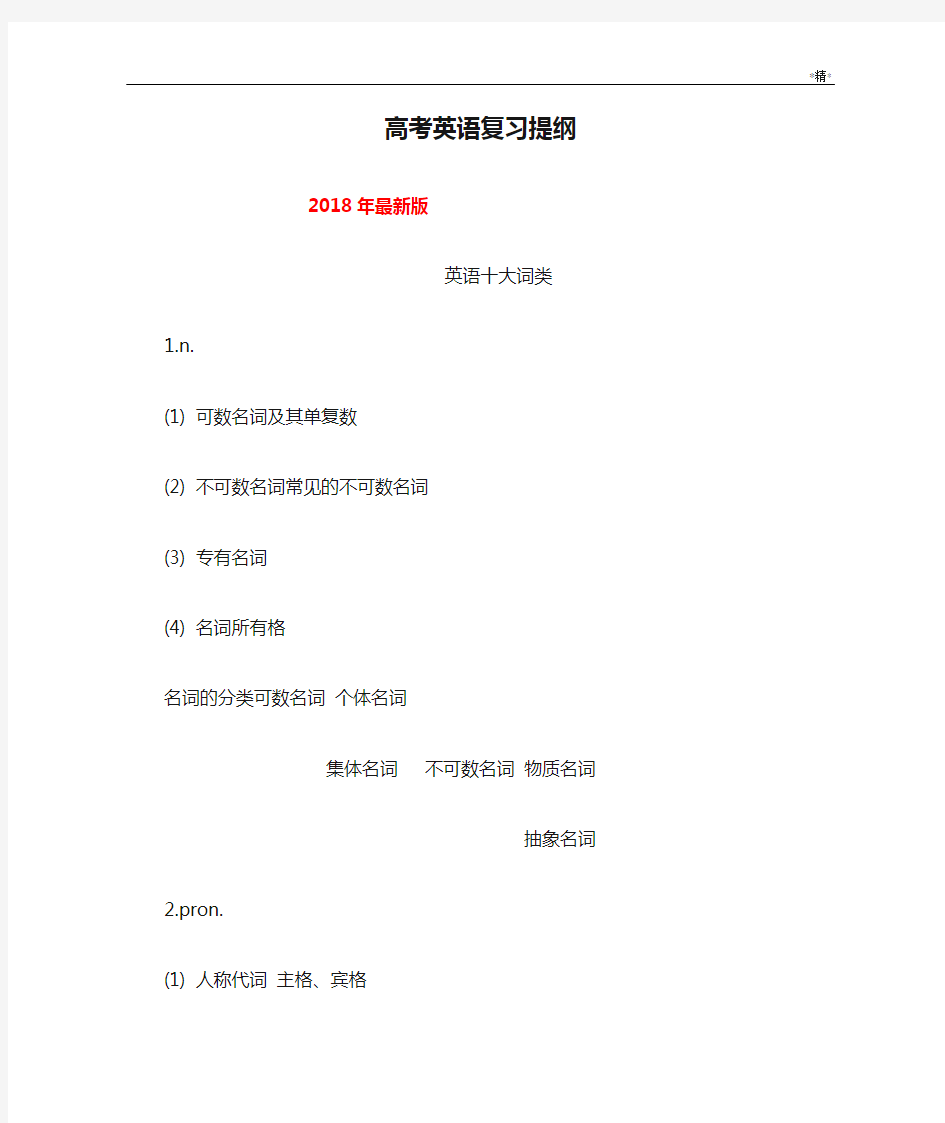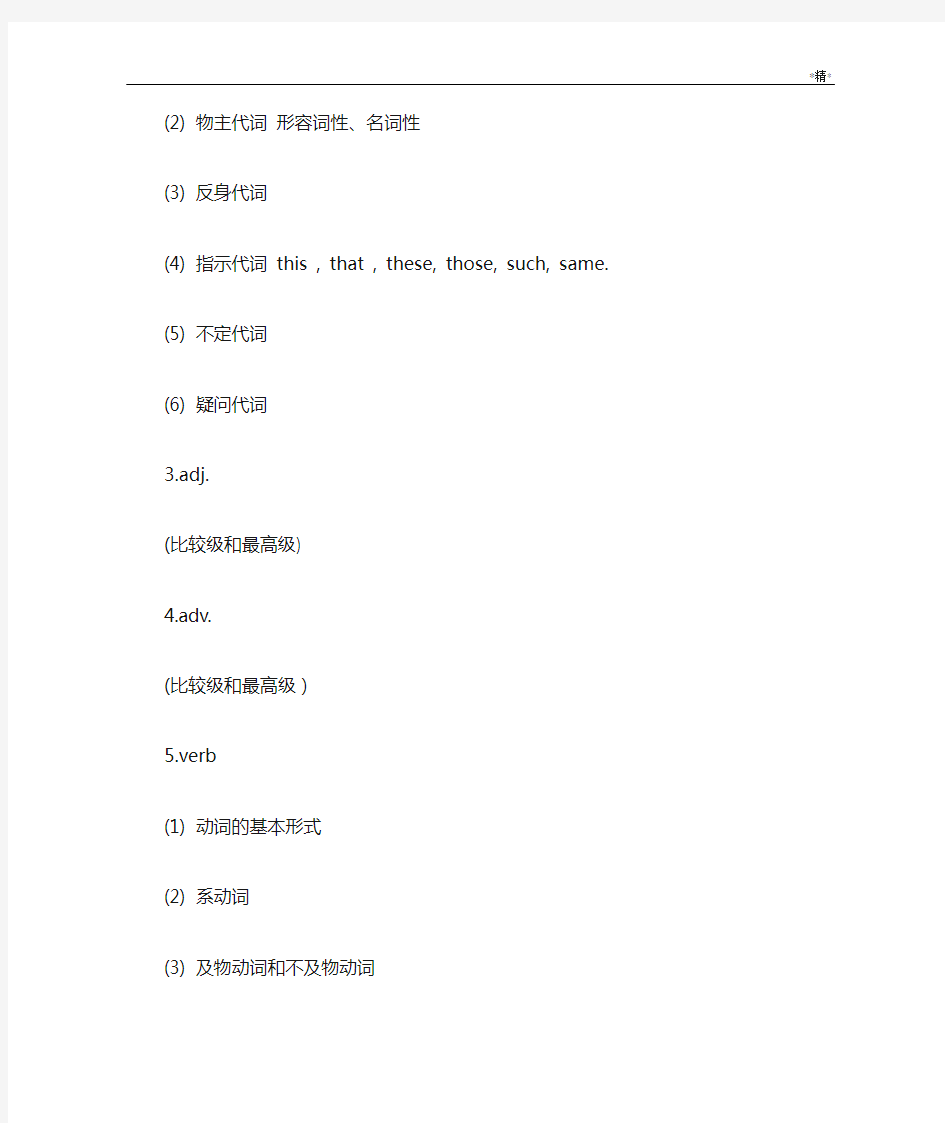2020年最新版高考英语复习提纲


高考英语复习提纲
2018年最新版
英语十大词类
1.n.
(1) 可数名词及其单复数
(2) 不可数名词常见的不可数名词
(3) 专有名词
(4) 名词所有格
名词的分类可数名词个体名词
集体名词不可数名词物质名词
抽象名词
2.pron.
(1) 人称代词主格、宾格
(2) 物主代词形容词性、名词性
(3) 反身代词
(4) 指示代词this , that , these, those, such, same.
(5) 不定代词
(6) 疑问代词
3.adj.
(比较级和最高级)
4.adv.
(比较级和最高级)
5.verb
(1) 动词的基本形式
(2) 系动词
(3) 及物动词和不及物动词
(4) 助动词
(5) 情态动词
6.num.
(1) 基数词
(2) 序数词
表达倍数的几个句型
1倍数+as+adj/adv+as
2倍数+adj/adv.比较级+than
3倍数+the+性质名词+of
4The +n+be+倍数+what从句
5The +n+be+倍数+that从句
6.art.
不定冠词有a,an两种形式,辅音因素前用a;元音因素前用an. A useful animal, a university, a European car, a one-eyed dog, an hour, an honest boy, an X-ray, an ugly man, an honor.
8.prep.
介词和介词短语
介词的分类
1空间关系
2时间关系
3方式、方法、手段4方向
5数量
6除...以外
7“关于
8“具有”“没有”9原因
10“代替”
常用介词的用法
1 about
2 above
3 against
4 as
5 at
6 beyond
7 by
8 for
9 from
10 of
11 on
12 over
13 under
14 with
常考介词短语
9.conj.
10.interj.
八大句子成分
一、主语---句子的主体
主语是句子的主体,是句子所要说明的人或事物,表是句子描述的是谁或什么。通常由名词、代词、数词、不定式、动名词、从句充当。
二、谓语-----主语的行为
谓语用来描述主语的行为动作、状态或特征。实义动词可以单独作谓语,有时态、人称和数的变化,系表结构可以作谓语,助动词\情态动词+实意义动词可以作谓语。
三、宾语----动作的对象
宾语是动作的对象或承受者,vt+o vi+prep+o名词、代词、数词、不定式、动名词和从句可以作宾语。
四、表语----主语的特征
五、定语---名词的修饰语
形容词、名词、代词、数词、副词、不定式、动名词、分词、介词短语和从句可以作定语。
六、状语----动词、形容词、副词或句子的修饰语
七、补足语
八、同位语
句子的种类
句子: 简单句
并列句
复合句
形容词性从句(定语从句)
名词性从句(主、宾、表、同)
副词性从句(状语从句)
5种基本句型
一、主语+谓语(不及物动词)SV
二、主语+谓语(及物动词)+宾语SVO
三、主语+系动词+表语SVP
四、主语+谓语(及物动词)+(双宾语)间接宾语+直接宾语SVOO
五、主语+谓语(及物动词)+宾语+宾语补足语SVOC
常见的并列句
并列关系and, both...and, not only... but also, neither...nor.
转折关系but, yet, whereas
选择关系or, otherwise, or else, either... Or , not...but不是、、、、、、而是因果关系for,so, therefore, thus
对比关系while
6种从句(状语从句、定语从句和名词性从句)
状语从句
1 时间when, whenever, as, while, hardly...when, no sooner...than, scarcely...when, the moment, the minute, immediately
2 地点where, wherever
3 条件if, unless, providing/provided(that), as long as , so long as , only if,
4 原因Because of ,as , since, now that, seeing that,
considering that,
5 让步
6 比较as, than ,the same as, not so ...as, as ...as
7 方式as if,as though, as
8 目的that, in order that, so that, in case, for fear that, lest
9 结果so that, so...that, such...that,that
定语从句
1.关系代词who, whom, whose, that , which, as引导的定语从句
2.关系副词when, where, why引导的定语从句
3.介词+which/whom引导的定语从句
定语从句常用句型
1.As we all know.../As is known to all...众所周知
As we all know, Chinese knots are very popular with Chinese people. 2.As sb. puts it...按照某人所说的
As he often puts it, university education determines one’s future.
3.Such...as...
4.The same ...as
Her manner and attitudes towards him were quite the same as they had always been.
5.One of the +复数名词+定语从句
As far as I know, your sister is one of the students who have passed the exam.
6.The only one of the +复数名词+定语从句
Mr.Green was the only one of the workers that was invited to Beijing.
名词性从句(4种)
1主语从句
2宾语从句
3表语从句
4同位语从句
名词性从句的常用句型
1A is to B what C is to D
A book is to the mind what food to the body.
2.What impresses/surprise/shocks...sb. most is that...
3.It is+adj...that ...
I wonder whether/if...10.
4
英语时态
(1) 一般现在时
(2) 一般过去时
(3) 一般将来时
(4) 现在进行时
(5) 过去进行时
(6) 过去将来时
(7) 将来进行时
(8) 现在完成时
(9) 过去完成时
(10) 现在完成进行时
英语非谓语动词
非谓语动词包括动词不定式、v-ing和p.p
动词不定式:基本形式:to do (to是不定式符号),没有人称和数的变化,有时态和语态的变化,因此在句中可以作主语、表语、宾语、宾语补足语、定语和状语。
to do (一般式)
to be done (被动式)
to be doing (进行式)
to have done (完成式)
to have been done( 完成被动式)
1.作主语To see you is very glad.=It is very glad to see you.
2.作表语My hope is to see you.
3.作宾语I want to buy a car.
4.作宾语补足语The teacher asked him to clean the classroom.
5.作定语The meeting to be held tomorrow is of importance.
6.作状语He went to see you .
动词的-ing形式
动词的过去分词
动词的过去分词就是动词的-ed形式,它是非谓语动词的一种形式,也是历年来高考英语热点语法项目之一, 动词的过去分词仍保留着动词的许多特征,因此在句中可以有自己的状语和逻辑主语,及物动词的过去分词既表示被动又表示完成,不及物动词的过去分词只表示完成而不表示被动。过去分词的用法:
一、作定语,单个的过去分词作定语一般要放在它所修饰的名词前面,如果是过去分词短语要放在它所修饰的名词后面,相当于一个定语从句。少数动词的过去分词,如left 等,只能做后置定语。fallen leaves 落叶 boiled water 开水 developed country 发达国家
the risen sun 升起的太阳 a retired teacher 退休教师。Polluted air and water are harmful to people’s health. 污染的空气和水对人的健康有害。The story(written by him)is very interesting.他写的那部小说很有趣。I can’t give you any because there’s none left.我不能给你什么,因为什么也没留下。The watered flowers look quite beautiful in the sun .
二、作表语
过去分词置于系动词be ,get, remain, seem等之后作表语,表示主语所处的状态或性质,其用法相当于形容词,构成的谓语有时接近被动结构。
The door remained locked门仍然锁着。
He became inspired when he thought about helping ordinary people.
She felt very tired.她感到很累。
三、作宾语补足语
过去分词可以在一个作宾语的名词(或代词)的后面作宾语补足语与其一起构成复合宾语。此时,宾语与宾语补足语之间大多数存在着逻辑上的被动关系。即前面的名词(或代词)是后面的分词(短语)所表示的动作的承受者,并且该动作已完成。可以用于“谓语动词+宾语+宾语补足语”结构的动词通常分为三类:
1.表示感觉和心理状态的动词:如 see 、hear 、feel 、think 、watch 、suppose ,以及consider等。
I find my money stolen. 我发现我的钱被偷了。
I saw the river polluted when I came back two years later. 两年后我回到那里,发现那条河污染了。
2.表示“致使”意义的使役动词,如make 、get 、have 、keep 以及leave等。
Please keep us informed of the latest news. 请把最新消息告知我们。
3.表示“希望,要求,命令”等意义的动词,如like、 want、wish 、order 等
He ordered this work (to be) finished by tomorrow 他命令这项工作明天以前完成。
在have ,get 两个动词后,可用动词的过去分词作宾语补足语,表示特殊的含义。而表示遭受某种不愉快或不幸时,只能用have 不能用get .
I am going to have /get the bike mended .我要修一修自行车。He had his legs hurt in the game . 他在比赛中伤了腿。
Have sth.done 结构有三种不同的含义。
(1)表示“请/让/叫别人(为自己做某事)”的意思。
I must have my tooth pulled.(=I must let the dentist pull my tooth.)。我的把这颗牙拔了。
(2)表示“遭遇某种(不幸)事情。说明宾语的一种无意识的遭遇,不说明“谁使(宾语)遭遇某事”。I had my purse stolen on
the bus yesterday. ( =my purse was stolen on the bus yesterday.) (3)表示“完成某事”的意思,这些事可以是别人完成的,也可以是自己参与完成的。
I must have my homework finished before I go to play.
出去玩之前我必须先把作业做完。
四、作状语
过去分词作状语,表示动作发生的背景或情况,在意义上相当于一个状语从句,其省略的主语(也称逻辑主语)与主句的主语保持一致,过去分词在句中可以表示时间,原因,条件,方式或伴随以及陪衬性动作。过去分词作状语,句子中的主语为动作的承受者。
1.作时间状语,相当于时间状语从句。
Seen from the hill, the city looks magnificent.从山上看时,这个城市很壮观。
2.做原因状语,相当于原因状语从句。
Lost in thought ,he almost ran into the car in front of him.由于陷入沉思,他差一点撞上前面的汽车
Badly wounded in the leg(=as he is badly wounded in the leg ),he has to stay in bed.
腿受了重伤,他不得不躺在床上。
3.作条件状语,相当于条件状语从句。
Given good health ,I hope to finish writing the book this year . 如果身体好,我希望今年写完这本书。
4.作方式或伴随状语,相当于并列复合句。
The president entered the hall, ,accompanied by a group of leaders.
总统由一群领导陪伴着进入了大厅。
5.作让步状语,相当于让步状语从句。
Beaten by the opposite team, the players were not discouraged and practiced even harder (=Though they had been beaten)虽然被对方打败,五、独立主格结构
过去分词可以有其独立的逻辑主语,这种主语常是名词或代词的主格,放在过去分词之前,这种“名词/代词+过去分词”结构叫做独立主格结构,表示被动或完成的动作。(如果过去分词作状语,它的逻辑主语不是句子的主语时,那就要带上自己的主语,这就是独立主格结构)
The job finished ,we went home straight away .
工作完成后,我们径直回家了。
All things considered,we set out to do the job.
各方面都考虑进去,我们开始做这个工作。
语法填空题解题技巧
A类:无提示词纯填空(3-4个)
1冠词a , an ,the
2介词固定搭配固定短语(动词短语和介词短语)
给出介词----doing P.P+ by+doing
3代词
4连词
并列连词
①并列关系and, both...and, not only... but also, neither...nor.
②转折关系but, yet, whereas
③选择关系or, otherwise, or else, either... Or , not...but不是....而是
因果关系for,so, therefore, thus
对比关系while
从属连词从句引导词(状语从句、定语从句和名词性从句)n----谓语(这就是定语从句缺主语判断先行词是人用who还是物that/which)
B类:有提示词(6-7个)
1名词(单复数和所有格)
2动词谓语的变化(时态、语态和语气)
非谓语动词的形式变化(不定式、v-ing 和p.p)
3代词(三大类五小类)人称代词(主格和宾格)
物主代词(形容词性和名词性物主代词)
反身代词
4形容词和副词的转换与等级比较级+er/more\less;最高级+est /most\least
5词的派生
名(n.)动(v.)副(adv.)形(adj.)
英语短文改错题解题技巧
要求:满分10分,错误类型有3种情况1、缺词用(^);2、多词用(\)删掉该词;3、错误在该词下划线(用----)然后改正,只改一个单词。
1.冠词a, an, the 用/ 不用/ 误用
2.名词可数名词和不可数名词
3.代词偷换人称代词(阴、阳;主格、宾格、形容词性物主代词、
名词性物主代词、反身代词)
4.形容词和副词的混用
5.连词及平行结构and / but/ so /or 等
6.习惯用语和固定搭配的用法
7.6种从句引导词问题(定语从句、状语从句以及名词性从句)
8.主谓一致和非谓语动词(不定式,动名词,从句可以做主语)的
问题
9.时态、语态和语气(文章的主体时态)
10.逻辑问题
书面表达高级词汇
名词chance-opportunity choice-alternative
idea-opinion effect-influence
people-individuals result-consequence
动词bear-put up with understand-make sense of have-possess replace-substitute
develop-promote consider-take into account
形容词enough-adequate rich-abundant
proper-appropriate important-vital\significant
interesting-absorbing\appealing difficult-challenging 副词finally-eventually hardly-barely
immediately-in a flash nowadays-currently
连词so-therefore and-as well as
常用标点符号(punctuation)
英语书面表达常用的标点符号有:
句号(full stop/period)、逗号(comma)、分号(semicolon)、引号(quotation mark)、冒号(colon)、问号(question mark)和感叹号(exclamation)、省号(ellipsis mark)、破折号(dash)、连字号(hyphen)。
英语书面表达常用句式
1表示好处
It has the following advantages.
It does us a lot of good.
It benefits us a lot.
It is beneficial to us.
It is of great benefit to us.
There are many advantages in doing it.
2表示坏处
It is harmful to us .
It does us much harm.
It has more disadvantages than advantages.
表示措施
We should take some effective measures to solve the problems that we
are faced with.
We should try our best to overcome the difficulties.
Measures must be taken to…
2017年高考英语考试大纲
考核目标与要求
一、语言知识
要求考生掌握并能运用英语语音、词汇、语法基础知识以及所学功能意念和话题(见附录1至附录5),要求词汇量为3500左右。
二、语言应运
1.听力
要求考生能听懂所熟悉话题的简短独白和对话。考生应能:
(1)理解主旨要义;
(2)获取具体的、事实性信息;
(3)对所听内容做出推断;
(4)理解说话者的意图、观点和态度。
2.阅读
要求考生能读懂书、报、杂志中关于一般性话题的简短文段以及公告、说明、广告等,并能从中获取相关信息。考生应能:
(1)理解主旨要义;
(2)理解文中具体信息;
(3)根据上下文推断单词和短语的含义;
(4)做出判断和推理;
(5)理解文章的基本结构;
(6)理解作者的意图、观点和态度。
3.写作
要求考生根据提示进行书面表达。考生应能:
(1)清楚、连贯地传递信息,表达意思;
(2)有效运用所学语言知识。
4.口语
要求考生根据提示进行口头表达。考生应能:
(1)询问或传递事实性信息,表达意思和想法;(2)做到语音、语调自然;
(3)做到语言运用得体;
(4)使用有效的交际策略。附录3功能意念项目表1. 社会交往(Social Communications)
(1) 问候(Greetings)
(2) 介绍(Introduction)
(3) 告别(Farewells )
(4) 感谢(Thanks )
(5) 道歉(Apologies)
(6) 邀请(Invitation)
(7) 请求允许(Asking for permission)
(8) 祝愿和祝贺(Expressing wishes and congratulations)
(9) 提供帮助(Offering help)
(10) 接受和拒绝(Acceptance and refusal)
(11) 约会(Making appointments)
(12) 打电话(Making telephone calls)
(13) 就餐(Having meals)
(14) 就医(Seeing the doctor)
(15) 购物(Shopping)
(16) 问路(Asking the way)
(17) 谈论天气(Talking about weather)
(18) 语言交际困难(Language difficulties in communication)
(19) 提醒注意(Reminding)
(20) 警告和禁止(Warning and prohibition)
(21) 劝告(Advice)
(22) 建议(Suggestions)
2. 态度(Attitudes)
(23) 同意和不同意(Agreement and disagreement)
(24) 喜欢和不喜欢(Likes and dislikes)
(25) 肯定和不肯定(Certainty and uncertainty)
(26) 可能和不可能(Possibility and impossibility)
(27) 能够和不能够(Ability and inability)
(28) 偏爱和优先选择(Preference)
(29) 意愿和打算(Intentions and plans)
(30) 希望和愿望(Hopes and wishes)
